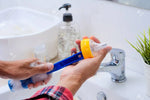
The Essential Guide to Baby Feeder Brushes: Keeping Your Little One's Feeding Equipment Clean and Safe
, by Ahsan Amaan, 5 min reading time

, by Ahsan Amaan, 5 min reading time
When it comes to caring for your little one ensuring their feeding equipment is clean and safe is of utmost importance. Baby feeder brushes play a vital role in maintaining the hygiene of your baby's bottle nipples and other feeding accessories.
In this comprehensive guide, we will discuss the importance of using baby feeder brushes how to choose the right one and provide useful tips for keeping your baby's feeding equipment clean and safe.
Using a dedicated baby feeder brush is essential for maintaining cleanliness and preventing harmful bacteria from accumulating on your baby's feeding equipment. Regular brushes may not effectively clean the narrow and hard-to-reach areas of bottles and nipples increasing the risk of bacterial growth.
Baby feeder brushes are designed with soft bristles and specialized shapes to reach every nook and cranny ensuring a thorough cleaning.
When selecting a baby feeder brush consider the following factors:
Opt for brushes with soft flexible bristles to prevent scratching or damaging the bottles and nipples. Silicone or nylon bristles are commonly used and are gentle yet effective in removing residue.
Choose a brush that matches the size and shape of your baby's feeding equipment. Look for brushes with a smaller head and long handle to clean narrow bottles and reach deep into nipples.
Ensure the brush has a comfortable grip preferably with an ergonomic design allowing you to clean the feeding equipment without straining your hand.
These baby feeder brushes with all the above features are easily available at mama love's online baby store.
To clean your baby's bottles and nipples effectively follow these steps:
Start by rinsing the bottles and nipples with warm water to remove any milk or formula residue. Then prepare a cleaning solution using warm water and baby-safe dish soap.
Using your baby feeder brush apply the soapy water solution and gently scrub the inside of the bottles paying close attention to the bottom and sides. Rinse thoroughly with warm water to remove any soap residue.
For cleaning the nipples use the brush's smaller head to reach inside and clean out any trapped milk or formula. Pay attention to the holes ensuring they are clear from blockages. Rinse thoroughly.
Sterilization is a crucial step in maintaining the hygiene of your baby's feeding equipment. After cleaning consider sterilizing the bottles and nipples using boiling water steam sterilizers or specialized sterilizing devices. Sterilization eliminates harmful bacteria ensuring a safe feeding environment for your little one.
To ensure the longevity and effectiveness of your baby feeder brush keep the following tips in mind:
After each use rinse the brush thoroughly with warm water to remove any remaining soap or residue.
Allow the brush to air dry completely in a clean and well-ventilated area. Avoid storing it in closed containers or damp environments to prevent bacterial growth.
Inspect the brush regularly for signs of wear and tear. If the bristles become frayed or damaged it's time to replace the brush to maintain optimal cleaning performance.
To ensure the safety and cleanliness of your baby's feeding equipment avoid the following common mistakes:
Avoid leaving bottles and nipples unwashed for an extended period. Clean them promptly after each use to prevent the buildup of bacteria.
Do not use harsh cleaning agents such as bleach or abrasive cleaners as they may leave harmful residues and damage the feeding equipment.
To extend the lifespan of your baby feeder brush consider these tips:
Keep the brush in a clean and dry area away from direct sunlight. Storing it in an upright position will help maintain its shape and prevent deformation.
While it's essential to clean thoroughly avoid applying excessive force that may cause bristle damage or deformation.
If you prefer alternative cleaning methods consider the following options:
Some baby bottle sterilizing solutions do not require a brush and offer a convenient way to keep your baby's feeding equipment clean. Follow the manufacturer's instructions for proper usage.
Certain bottles and nipples are dishwasher-safe. Ensure they are placed on the top rack of the dishwasher and use a gentle cycle to avoid damage.
When traveling it's important to keep your baby feeder brush clean and protected. Consider these tips:
Invest in a travel case specifically designed for baby feeder brushes. These cases protect the brush from dirt and damage while on the go.
After each use during travel rinse the brush with clean water and let it air dry before storing it in the travel case.
Ensuring the cleanliness and safety of your little one's feeding equipment is crucial for their well-being. By using a dedicated baby feeder brush and following proper cleaning and sterilization techniques you can provide a hygienic environment for feeding your baby.
Remember to choose the right brush handle it with care and maintain regular cleaning routines to keep your baby healthy and happy.